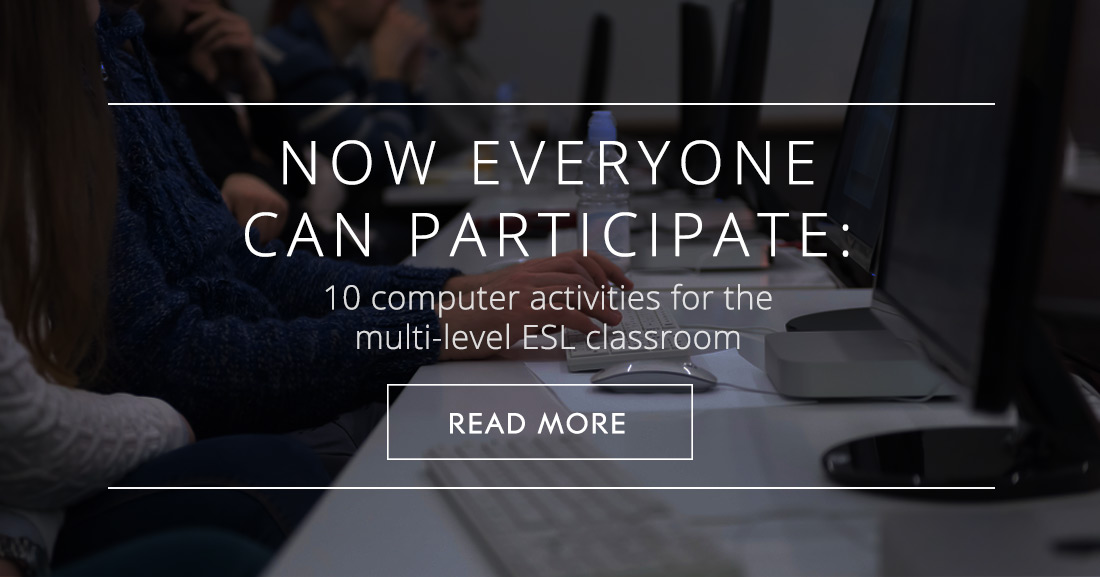Something for Everyone: Reaching Even Lowest Level of ESL in the Multi-Level ESL Classroom


ESL classes are diverse in every sense of the word—not only in the students’ cultural and language backgrounds but also in level of acquisition of English. Even if the students are all at an “intermediate” level, for example, there are degrees of “intermediate” between the students and then even within the individual student and his or her specific English skills: for example, intermediate level in reading and writing but closer to beginning in speaking and listening, for example.
This multilevel nature gets even more compounded once computers are introduced in the ESL classroom: now students are not only diverse in cultural background and English skills but also ability in computer use, with some students very computer literate and then others with very limited abilities.
The diverse nature of the class may seem at this point unmanageable, but in fact there are a number of ways to serve every student and develop her or his English and computer skills at the same time in the multilevel computer-assisted classroom. In fact, this seeming barrier may be turned into an advantage as developing English skills and computer skills can occur together and in fact feed off each other. The instruction and curriculum and its sequence, however, have to be carefully planned.
Integrate computers in the curriculum gradually. Some students may need basic instruction in the functions of the computer: turning it on, off, creating a word document, and so forth. More advanced instruction or review can be introduced here as well, for the students who have basic computer understanding, such as using word commands, creating a PowerPoint document, and setting up a basic webpage. Handouts and posters on basic procedures for easy reference can help.
Computers in the classroom provide the opportunity for flexible configurations of students. One part of the class can work on computers, while the other on speaking/listening activities. This is one way to address the multilevel nature of the class as those students who need most attention on their speaking skills can work on them while the more advanced students, who would otherwise be bored during this instruction, can work on their computer skills.
One of the contributions of computers to the classroom is that instruction can be individualized. A plethora of websites free of charge or nearly offer a variety of ESL activities. There are even free typing sites where students can learn keyboarding at the same time they may be learning the alphabet, an example of the way instruction in English and computers can “feed off of each other”: while engaged in basic typing exercises, students actually are learning English words and sentences through the visual and tactile nature of typing itself but also repeated exposure. Repeated exposure to a word is the way it is learned.
Students can also work together, reading each other’s compositions and commenting on them. Often classes come equipped with a Learning Management System/course website, and students can post their written work there for peer comment. If there is no Learning Management System, the class can create its own website (more on this later) or simply switch seats with each other (or pass their laptop to their peer) to read each other’s work.
Students can work together researching on the Web or viewing and discussing video/news clips and so forth. Something as simple as pulling up a clip of boxing match, for example, can lead to a discussion and writing on the topic of violence in sports.
Microsoft Word has editing functions with which students can type comments for revision on their peers’ work. The comments can be turned off once students have read them.
Revision is much easier in a word processing program: cutting and pasting text and changing it are much easier than when simply typing.
Research is traditionally done in teams. A team can decide on a topic of common interest to research. As most of us know, the Web now has a plethora of resources for research, of varying credibly. The instructor can give some basic instruction on evaluating source material or simply guide students to the school’s online library—most colleges’ libraries have gone online—where the sources have already been filtered for credibility. The topics should be of common group interest: almost any topic is appropriate for research and has a body of literature associated with it. For example, some of my students spent some time “researching” videogames—playing them as they researched, I’m sure. But they did turn in a credible paper that they also presented to the class, in which they debunked the notion that playing videogames leads to violent behavior. They even went somewhat beyond the assignment requirements, actually interviewing videogame enthusiasts who have some expertise on the topic. In other words, this was research with primary sources that they were not asked for, and in fact it was a step beyond that of most of the published research. Students in fact critiqued the published research: it was mostly secondary, in which the interviewers did not look at actual videogames nor interview people who played them. While engaged in this research, students were improving reading, writing, speaking, and critical thinking skills—in a way they would not have done in class without computers.
These sites are multilevel, with reading, writing, discussion, pronunciation, and vocabulary activities. Some popular sites are Dave’s ESL Café, ESL Gold, and ESL Galaxy. Many sites are free or offered for a nominal charge; the school might want to consider a site license for those that are not. Most are user-friendly, with minor orientation by the teacher needed before students can work on their own.
The class can work together setting up a webpage—either for the class as a whole or for themselves. There are free, user-friendly platforms for creating websites available now, such as Weebly. Increasingly, a website is becoming an asset or even a necessity in showcasing one’s professional skills, and knowing how to set up a website can be a real advantage in the twenty-first century workforce.
Rather, through gradual integration of the computers in the classroom, using flexible student groupings, and planning a variety of activities, the computers can be an advantage and integral part of the class.